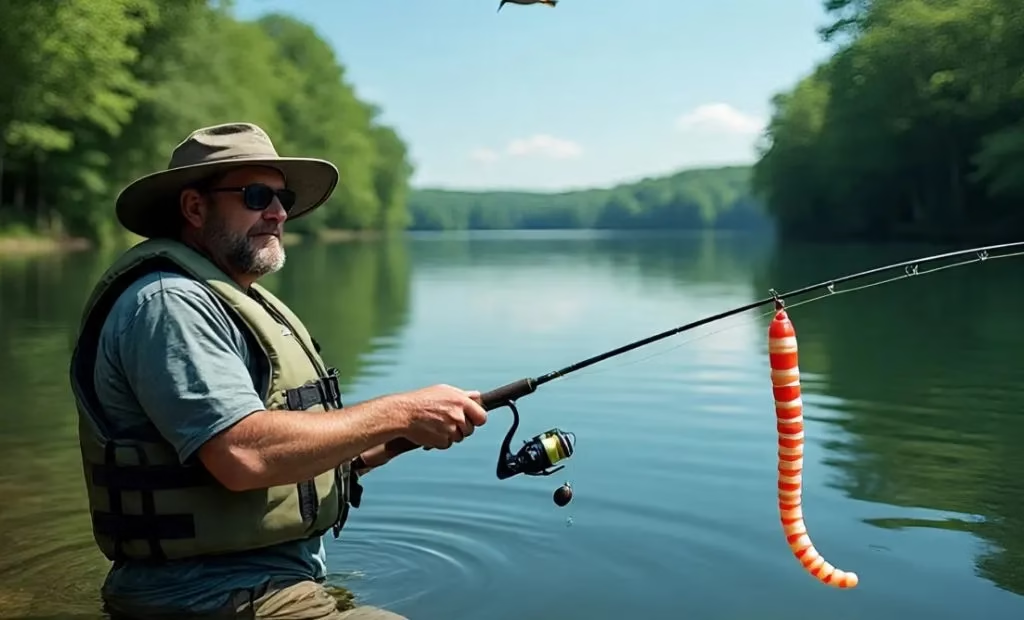How to Fish a Wacky Rig Fishing is more than just growing up a line; it’s also about knowing what works, when it works, and how to make the most of every trip. Because of its efficacy and ease of usage, one technique is especially well-liked by American bass fishermen: the wacky rig. Unlike many others, the strange configuration is both easy enough for beginners to use and powerful enough for experienced professionals. It is found in lakes, rivers, ponds, and reservoirs from Florida to California.
Understanding the Wacky Rig
Than, we start rigging, it is important to understand what makes a How to Fish a Wacky Rig distinctive. To present it in a straight or natural way, most bass fishing rigs hook a soft plastic worm at one end. But you use a wacky setup to hook the worm into the middle. The worm’s peculiar positioning makes both ends move as it falls, giving it a genuine dying-baitfish aspect that makes it enticing to bass. The best thing about this rig is its subtle, fluttering movement; it doesn’t require expensive gear or hard retrieves. Another reason the wacky rig is so well-liked by fisherman is its versatility.
What You’ll Need to Fish a Wacky Rig
A big tackle box is not necessary for fishing a wacky rig, but having the right gear makes it much more effective. The first thing you’ll need is a pack of soft plastic worms; stick-style models such as the Zoom Zlinky or Yamamoto Senko are popular because they’re durable, easy to rig, and have a proven track record of catching fish. Then choose the right crazy hooks. Wide-gap, short-shank hooks designed specifically for wacky rigging boost hook-up rates and hold the worm in position. Some anglers also prefer to use O-rings or other strange tools to hook the worm without piercing the plastic. In the end, this saves money by extending the bait’s lifespan.

Step-by-Step: How to Rig a Wacky Worm
Now that you have everything you need, it’s time to set up. It’s simple to rig a weird worm, but it’s important to do it right. Do the following How to Fish a Wacky Rig:
1. Select Your Worm
2. Prepare the Hook
3. Find the Center of the Worm
4. Fasten the Hook
5: Confirm Equilibrium
How to Fish a Wacky Rig Effectively
You have to learn How to Fish a Wacky Rig in different conditions and allow the bait’s natural motion do the heavy lifting if you want to catch fish. Rigging is just the beginning. Start by casting the worm out toward structures such as docks, brush piles, grass edges, or rocky transitions, as most strikes occur while the worm is fluttering down. Then, without reeling or jerking too soon, let it sink naturally. This is where this rig’s real magic occurs. Once it settles down, gradually raise the tip of your rod a few inches and then let the worm descend again to create little pauses and twitches.
When and Where to Use the Wacky Rig in the U.S.
Bass in the United States react differently depending on the season, so knowing when and where to utilize a wacky rig can make all the difference in How to Fish a Wacky Rig. When bass move into shallow water to spawn in the spring, it may be extremely deadly to pitch a foolish worm near beds or shallow cover because the slow, subtle fall often triggers defensive strikes. Because fish like to migrate deeper during the day, using a crazy rig to target drop-offs, shady docks, or submerged vegetation keeps bass interested even when the bite slows down in the summer.
Common Mistakes to Avoid
How to Fish a Wacky Rig is one of the simplest and most effective rigs, a few frequent blunders can severely reduce your chances of catching bass. One of the biggest blunders is to work the bait too aggressively. Since the How to Fish a Wacky Rig wacky rig relies heavily on dexterity and its built-in motion does the job for you, less is unquestionably more. Another mistake that anglers make is to ignore line sensitivity. Light tension on your line is essential to catching delicate strikes before the fish spits off the bait. Wacky worm bites often feel like gentle “ticks” or a little shift in pressure.
Pro Tips to Catch More Bass on a Wacky Rig
If you already understand the basics of fishing a crazy rig, a few more techniques will help you catch a lot more bass How to Fish a Wacky Rig. One of the finest modifications is to use a fluorocarbon leader with a braided main line. The braid gives you strength and sensitivity, while the fluorocarbon leader is nearly undetectable underwater, making it harder for wary bass to find. It’s also a good idea to match your worm’s color to the properties of the water. In clear lakes or rivers, natural colors like watermelon or green pumpkin look great, but in murky water with low visibility, darker or brighter alternatives stand out more.
Why the Wacky Rig Should Be in Every Angler’s Arsenal
You may fish all around the United States with crankbaits, jigs, spinnerbaits, topwater, and more. But few lures are as basic, adaptable, and reliably effective How to Fish a Wacky Rig. Bass can be caught with this setup by both tournament pros and novices. It works effectively in ponds, rivers, and large lakes. It catches many fish, often some of the biggest in the area. No matter how long you’ve been a bass angler, one of the best things you can do is learn the wacky rig. It’s proof that little is more in some situations.
Final thoughts
How to Fish a Wacky Rig a crazy rig requires more than just tying a worm; you also need to understand why it works, where to use it, and how to let its natural activity do the heavy lifting. Once you get the hang of it, it’s one of the most reliable ways to fish for American bass. The next time you hit the water, give it a try. Be mindful of areas where bass hide or feed, approach slowly and steadily, and listen for those subtle taps that signal a strike.




